1979 Monaco Grand Prix race report
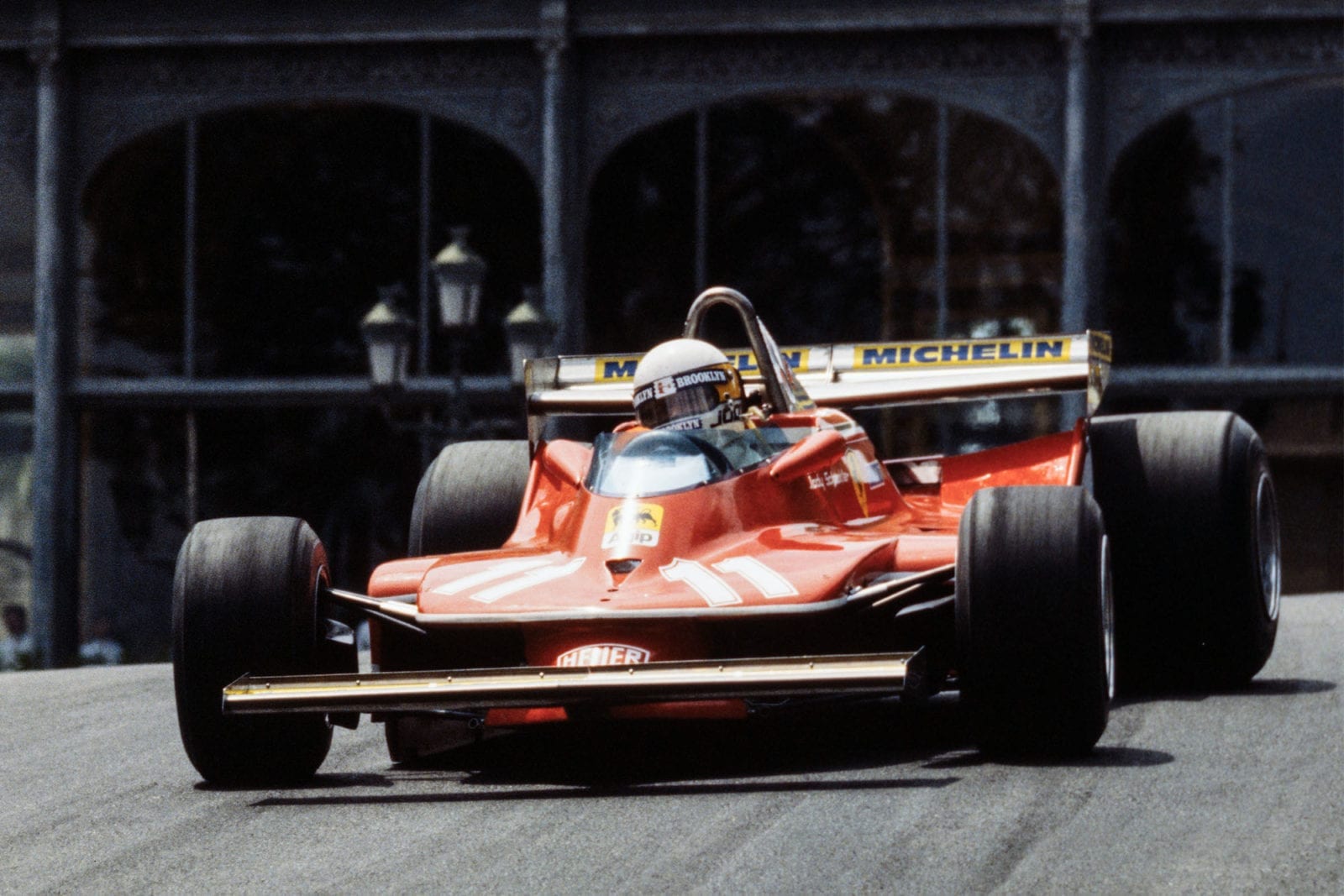
Jody Scheckter mastered the streets of Monaco in his Ferrari
Motorsport Images
Some good fighting
Monte Carlo, May 27th
This year’s race round the streets of Monte Carlo was the thirty-ninth Grand Prix to be held in the Principality, but more important, it was also the fiftieth anniversary of the first Monaco Grand Prix, the missing eleven races being accounted for by the war years and bouts of financial depression. With the size and speed of today’s Formula One cars it was deemed prudent to limit the number of starters to 20. This number coincides neatly with the accepted membership of the Formula One Constructors Association, but to invite them all, to the exclusion of everyone else would have been too simple, and very unpopular. The organisers studied the rule book and dug about in the small print and found their solution. They were permitted to allow 24 cars to practise, the fastest 20 taking the grid positions, and of the extra four cars they were allowed to nominate two entries themselves, while a pre-practice qualifying session was permitted in which the two fastest cars could make up the official total of 24. So Bernie Ecclestone turned up with this twenty boys, the organisers invited Rene Arnoux, to keep Renault and the French populace happy, and Riccardo Patrese to attract as many Italians over the border as possible. This left Stuck (ATS), Merzario (Merzario), Mass (Arrows), Rebaque (Lotus), Giacomelli (Alfa Romeo) and Brancatelli (Kauhsen) out in the cold. Alfa Romeo and Kauhsen had no intention of taking part and the Rebaque team withdrew under protest, Mr. Ecclestone having guaranteed them an entry at the end of last season! Arturo Merzario damaged his right hand while flapping his arms about in his garage, so he nominated Brancatelli to take his place and early on Thursday morning the black and yellow Merzario car was joined by Stuck (ATS) and Mass (Arrows) for a desultory hour’s running to decide who was to drop out. Needless to say it was Brancatelli, the two Germans joining “Bernie’s Boys” and the invited pair to start the serious business of the Monaco Grand Prix.
Qualifying
Due to jollifications, parties, Renault 5 practice and Formula Three practice all taking place on Friday, the Formula One practice was held on Thursday and Saturday, starting with a test-session between 10 a.m. and 11 a.m. and timed practice from 12.30-14.00 hours on Thursday. This test hour was vital, because there is no possibility of pre-practice testing or tyre-testing sessions through the streets of the Principality and lots of things like gear ratios and tyres had to be “guesstimated” beforehand. The two Ferraris of Scheckter (040) and Velleneuve (039) were using forward mounted rear aerofoils, both the Renaults were using twin turbo-chargers on their V6 engines, Lotus were still running their one Type 80 (Andretti) with three Type 79 cars to back it up, one (79/2) for Reutemann and a spare for each driver. Ligier had a brand new JS11 being held as the team spare, the 1979 Ensign re-appeared for Daly, but Fittipaldi was still using his old F5A/1. Brabhams had their usual three cars for Lauda and Piquet, with the prototype BT48/01 in a box as spares. Frank Williams’ team had a third FW07 model nearly completed and Hunt was concentrating on the Wolf WR7, with the newer car WR8 as stand-by. McLaren were having another stab at being competitive with a C-version of the M28 for Watson and Tambay had the B-version.
Mechanically the scene was pretty strong, but there was weakness on the driver front. Nelson Piquet stopped and got out of his Brabham-Alfa feeling decidedly queasy, which was just as well for his engine had developed an oil leak underneath. The Ligier team were in a sorry state for Depailler’s accident in Belgium had left him with a weak wrist and Laffite’s right wrist had given way while doing some test-driving, the cause being an old injury from some time ago. The two Frenchmen seemed to spend most of the time explaining how they were being brave and courageous and doing very well, in spite of the injury, and suggesting that the other one was exaggerating on the extant of his pain!
The afternoon session saw a lot of frantic activity for the Monaco circuit calls for a lot of “do-or-die” action, rather than scientific softly-softly progress. You can either drive over the limit, bouncing over the bevelled kerbs, brushing the steel barriers, locking up the brakes, powering out of corners on opposite lock, and generally being pretty unruly, in the hope of keeping it all together for a whole lap, with a subsequent fast time, or you can practise care and judgement, conserving the car and remembering the race has to be over 76 laps. Most drivers seemed to be desperate. Tambay walked back, having run out of petrol, Jabouille stopped out on the circuit with no drive to one rear wheel, because of trouble with the studs that transmit the drive to the wheel, Piquet was still losing oil from his Alfa Romeo V12 engine, Lauda was having his front springs changed, Scheckter was trying the rearward mounted rear aerofoil on his Ferrari and Arnoux was stuck at the pits with the same trouble as Jabouille. This loosening of the driving studs was no doubt due to expansion problems in the alloy hub carrier because of the brakes being outboard, and integral with the hub carrier.
From the wiggly bit of the circuit on the harbour front, around the swimming pool, came a sickening thud as Reutemann hit the steel barrier and stove in the left-front corner of Lotus 79/2. He walked back to the pits and 79/4 was made ready, but he only did a lap in it as the left front hub developed trouble, so it was a very disgruntled Argentinian that ended the afternoon. Meanwhile the Lotus 80 had also gone missing, but this was merely a shortage of petrol, luckily just before the pits, so the Lotus mechanics were able to take a churn of petrol to the car and get it going again. Daly was plagued by a misfiring engine in the Ensign, which much later was traced to “foreign matter” in a fuel filter, and Alan Jones had pranged his Williams on the far side of the circuit and ended his practice quite early on with a bent monocoque. Pironi had also pranged, damaging the monocoque of his Tyrrell, and had to transfer to the spare car.
Before practice was finished Piquet’s engine blew up, Stuck walked in from engine trouble on his ATS and took the spare ATS and Lauda had given up trying. From the times being recorded it was obvious that something was wrong, for the two Ferraris were some two to three seconds faster than the rest of the fast runners. The reason was tyres. Michelin were feeding the Ferrari drivers with all the tyres they wanted, from hard race-tyres to super-soft short-life tyres, while Goodyear were in trouble as their supplies of soft tyres had not arrived, and everyone was having to use “cooking” tyres. With Jones out of the running quite early due to the accident, the two Renaults in trouble, the two Ligier drivers nursing their wrists, and no super-sticky Goodyear tyres, the results of practice were confused to say the least. With Fittipaldi in fifth place, Regazzoni in fourth place and Lauda third, behind the two Ferraris there was obviously going to be some changes made on Saturday. For a long while Scheckter was holding FTD in the mid 1 min. 27 sec. area, but just when it all seemed settled his young team-mate Villeneuve shattered everything with 1 min. 26.91 sec., saying he was lucky to have everything come right on that one lap. Even so, he had to be ready for such a lucky break and he had to drive hard, luck or no luck.
It was a good thing that there was no practice on Friday as it allowed the teams time to repair or replace the ravages of the afternoon. New engines were installed, new gearboxes, gear ratios and brakes were changed, air ducts to cool the brakes were modified and a lot of work went on. The Williams lads completed FW07/003 for Alan Jones, the Tyrrell team abandoned 009/1 and settled on 009/4 for Pironi and Lotus abandoned 79/2 and fettled-up 79/4 for Reutemann.
Things started in earnest again on Saturday morning with another hour test-session, held a bit earlier in order to pack in the full day of Renault 5 racing, BMW racing, historic practice and F3 racing. Reutemann was in Lotus 79/4, Pironi Tyrrell 009/4, Piquet had a new V12 Alfa Romeo engine, Stuck had another Cosworth in the newer ATS, the Renault team had solved their loosening stud problem, Ensign had found the cause of their misfire, and Alan Jones had a brand new Williams FW07, the third to be built. Goodyear’s supply of practice tyres had arrived and with only sixteen cars on the Wolverhampton rubber it was decided to give everyone some sticky “go-faster” tyres. Whether everyone, and that means designer, team-manager and driver, was capable of making the best use of these special tyres, normally reserved for the chosen few, was another matter. During the morning while everyone got themselves tweaked-up for the all-important hour-and-a-half of timed practice in the afternoon, Reutemann found his back hurting, as a result of this Thursday accident, the two Ligier drivers were being “brave” and trying to out-psyche each other, and Lammers was out in the spare Shadow as his own car had broken a drive-shaft, a not unusual breakage in the rough and tumble of Monte Carlo.
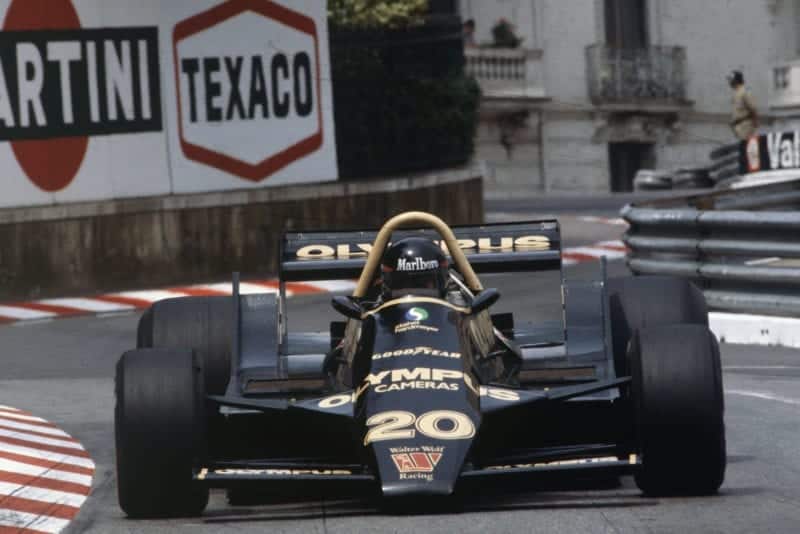
James Hunt qualified his Wolf 10th for what turn out to be his last race in Formula One
Motorsport Images
While everyone was lining up to leave the pits Villeneuve’s Ferrari was strewn all over the place. A leak had developed in the bottom of the fuel tank, requiring the Ferrari mechanics to work “blind” with arms stretched down through the top inspection panel. The little French-Canadian sat quietly in the pits while everyone else began to aim for good grid positions. There was the spare Ferrari (038) available but he preferred to wait until his own car was finished. The work was tedious and slow and the first half hour soon ticked by. Scheckter was really trying hard and soon improved on Villeneuve’s Thursday time, to take pole-position, and a couple of Ferrari mechanics were despatched across the pit lane to get the T car ready for Villeneuve, just in case. While Scheckter was holding pole position and Villeneuve was in second place all was well, and for some time none of the others looked like approaching the 1 min. 27 sec. barrier, let alone getting below it. However, when Depailler got his Ligier round in 1 min. 27.11 sec. the warning bell was ringing and Villeneuve joined in the practice with the spare Ferrari T4. It was nearly half way through the session before his proper car was finished and he then came in and transferred to it, soon getting below 1 min. 27 sec. and approaching Scheckter’s FTD of 1 min. 26.45 sec.
Next door to the Ferrari pit was the Renault team and they were in terrible trouble once again, for Jabouille was stranded out on the circuit with a broken transmission. He walked back to the pits and Arnoux was brought in, and after a bit of a squeeze Jabouille was fitted into Arnoux’s car and went off to try for a grid position. Meanwhile this spare Renault, the single turbo RS01/03 was got ready for Arnoux to drive. Before he did so Jabouille was back to report that he could not get comfortable enough in his little team-mate’s car to drive it properly so he had to give up. Arnoux got back into his own car and the RS01 was abandoned for in no way could it go as fast as the car Jabouille had abandoned out on the circuit.
The Brabham team were not much better off for Piquet’s car broke its Alfa Romeo engine, a brand new unit only installed the day before, and Lauda was sitting waiting for an opportunity to try and get a clear run. The spare Brabham was got ready for Piquet, but somehow Monaco was not being a good event for the rising star from Brazil. His compatriot was also in trouble for the F5A Fittipaldi broke a drive-shaft joint as it was leaving the pits, which was fortunate in a way because it meant the mechanics could wheel the car back up the pit lane and attend to it. Another car that came to rest at the pit exit was Tambay’s McLaren M28B, but this was only a stalled engine and not enough air in the on-board starter system to restart; the McLaren mechanics were soon to the rescue.
As this all important timed session progressed the pace became almost frantic, but the overall scene was making more sense than Thursday’s practice. The two Ferraris were still in a class of their own, both drivers being in the 1 min. 26 sec. bracket, due to a combination of all things being right. The right tyres, the right engine characteristics, the right handling, the right brakes, the right gearbox and both were driving brilliantly. However, all the other hard drivers were well down in the 1 min. 27 sec. bracket, though none looked like knocking the two Ferraris from their position at the front. The Monaco grid is arranged in staggered form, to such an extent that it is virtually a one-by-one grid, so Scheckter was in row one, Villeneuve in row two, Depailler in row three, Lauda in row four, Lafitte in row five and so on. There was so much excitement up at the front of the grid that the back got hardly any attention at all, even though there were six or seven drivers trying desperately to avoid being left out. The Renault team’s troubles were not over, for Arnoux now stopped at the pits with a split in an exhaust manifold, which of course meant a loss of pressure for driving the turbine on that side, and a loss of boost from the compressor. As Jabouille and Arnoux were now in nineteenth and twentieth places in the times, it was a precarious situation for the French team, with de Angelis, Tambay, Lammers and Daly all trying to get on to the grid.
Shortly before the chequered flag put a stop to everyone’s efforts Lauda stopped at the pits and got out with a sheepish look on his face and explained to Gordon Murray that he had banged a guard rail with the left-rear wheel, and he wasn’t joking; he had been trying very hard. As the whole thing reached its climax, Villeneuve got very close to Scheckter’s time as he did his last flying lap, recording 1 min. 26.52 sec. to the South African’s 1 min. 26.45 sec. While Scheckter’s time was heroic you couldn’t see him driving at that pace for 76 laps, or the Ferrari standing up to the hammering over the kerbs and the fierce opposite-lock slides for that distance, whereas Villeneuve’s performance looked more likely to go the distance, nonetheless, Scheckter was securely on pole-position and in great fighting form. Almost overlooked in mid-field was the performance of Jochen Mass, who was a bit peeved at being made to pre-qualify, and this “needle” really got him going in the Arrows. He was eighth fastest overall, ahead of Jones, Hunt, Reutemann, Stuck, Andretti, Watson and his own team-mate Patrese. Truly an effort deserving an A. As practice ended and everyone’s fate was sealed, especially the last four drivers, Derek Daly hit the barriers and the Ensign ended practice dangling from a breakdown lorry with a bent left-rear suspension.
After all that the Renault 5 saloon racing and the BMW Pro-Car M1 racing was all a bit of an anti-climax and almost “light relief”. With the Grand Prix not due to start until half past three o’clock on Sunday afternoon there was adequate time for race preparation of the twenty cars that had qualified, while the two Shadows and Tambay’s McLaren were prepared in case anyone ran into trouble in the Sunday morning “warm-up” period. In fact, there was trouble on Sunday morning, but it did not allow any of the reserves to start. First of all the day dawned wet and grey and some people were recalling the time when Beltoise won in the pouring rain with the BRM, but by breakfast time things were improving rapidly and the roads dried quickly. During the half-hour warm-up session at 11.30 a.m. everyone was going fine when suddenly there was a big cloud of smoke along the pit straight and Villeneuve’s Ferrari could be seen ahead of it. The Ferrari had broken an oil pipe and unbeknown to the driver, until the oil warning light came on, the precious lubricant was spraying all over the back of the engine instead of circulating inside. It got back to the pits but the damage was done, so without more ado the car was rushed to the paddock to have the engine changed, his supply of flat-12 engines seemingly inexhaustible. As there was three and a half hours before the start there was no desperate panic.
Race
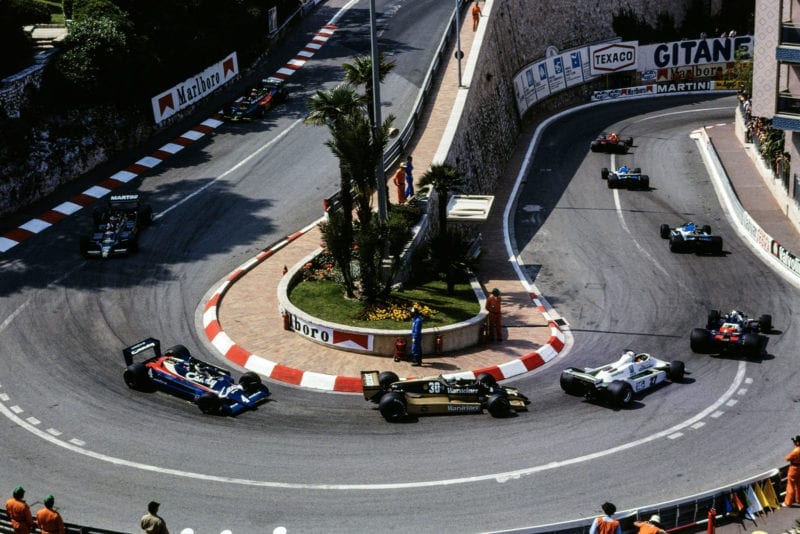
The field negotiates the Loews hairpin
Motorport Images
Eventually there were signs of the Grand Prix beginning to happen, for Prince Rainier and his Princess arrived and officially opened the circuit and the twenty starters were all warmed up and queueing up at the pit lane exit ready to go. They went round the circuit more or less in grid order and then lined up opposite the Royal box, with Alan Jones nipping into the pits for a quick adjustment and then going round for another lap before taking up his position. Scheckter led them all round on the pace lap in orderly fashion, they paused on the long grid, the red light came on, then the green and Scheckter made the most superb start and rocketed away towards the Ste. Devote chicane. Lauda was equally quick away from fourth position and passed both Depailler and Villeneuve before the corner and led the pack up the hill in pursuit of Scheckter. The South African wasn’t waiting for anyone and drove that first lap as if it was going to be his last, sliding out of corners on opposite lock and really giving the throttle a boot-full. The result was that he opened up a sizeable gap before some of his rivals were really under way. Remarkably, in view of some of the recent races, everyone survived the opening lap and were all still there on lap two, the order being Scheckter (Ferrari), Lauda (Brabham), Villeneuve (Ferrari), Depailler (Ligier), Lafitte (Ligier), Pironi (Tyrrell), Jones (Williams), Mass (Arrows), Jarier (Tyrrell), Reutemann (Lotus 79), Andretti (Lotus 80), Hunt (Wolf), Patrese (Arrows), Stuck (ATS), Regazzoni (Williams), Watson (McLaren), Fittipaldi (Fittipaldi), Piquet (Brabham), Arnoux (Renault) and Jabouille (Renault). Starting the third lap Villeneuve decided he had been behind Lauda long enough, and desperate situations called for desperate action. In an audacious bit of out-braking he bounced over the kerbs and past the Brabham-Alfa as they started the lap, and got away with it more by reason of Lauda’s co-operation than anything else. By this time Scheckter was almost out of sight, but the French-Canadian soon began to close up on him, leaving Lauda far behind. Following Lauda in a very close nose-to-tail “crocodile” were Depailler, Lafitte, Pironi, Jones, Mass, Jarier, Reutemann, Andretti and Hunt, the rest already being left behind. In quick succession Patrese and Hunt disappeared, the Arrows coming into the pits with its right-hand wheel leaning drunkenly and the Wolf stopping up the hill to the Casino with a broken drive-shaft joint. None of this affected the main issue, which was the way Villeneuve was closing up on Scheckter and the obvious way Lauda was not going fast enough for the eight cars that were queuing up behind him. At the back of the field Piquet and Arnoux had a slight coming together, which resulted eventually in the front end of the Renault bodywork collapsing, and there being no spares available for the RS10, Arnoux had to retire.
By lap 13 Villeneuve was right up behind Scheckter, though not looking for a way by, and they were ten seconds ahead of Lauda and the streaming mob that were following him. Pironi was in the middle of this lot and being swept along by the tide, possibly a bit out of his depth, and on lap 16 he collided with Laffite, which sent the Ligier into the pits for a new wheel and tyre and dropped it to the back of the field because the engine was reluctant to restart. Laffite stormed back into the race just ahead of the two Ferraris, so that he was virtually two whole laps behind, and he then drove really hard, pulling away from the Ferraris in the same manner that Villeneuve had done after his pit stop in the recent Zolder race. Anyone who had gone into a bar for a drink could have been excused for thinking Laffite was leading the race when they came out! Fittipaldi retired with a broken Cosworth engine. Not content with elbowing Laffite out of the way, Pironi now nudged Depailler into a spin, which put him almost to the back of the field, and then started to pressure Lauda. All the time he was being hard pressed by Jones, Mass, Jarier and the two Lotus drivers, though Reutemann began to lose ground when a split exhaust manifold pipe lost him a few hundred revs. As Lauda and Pironi started lap 22 the Tyrrell nose was right under the Brabham gearbox, and that was the last we saw of them. Down the hill from Casino Square to Mirabeau corner Pironi got the Tyrrell down the right-hand side of the Brabham and as Lauda turned into the corner the Tyrrell launched itself off the rear wheel and almost bounced on Lauda’s head as it sailed over the top, taking off the Brabham rear aerofoil. The Tyrrell crashed down and destroyed itself while the crumpled Brabham limped back to the pits to retire.
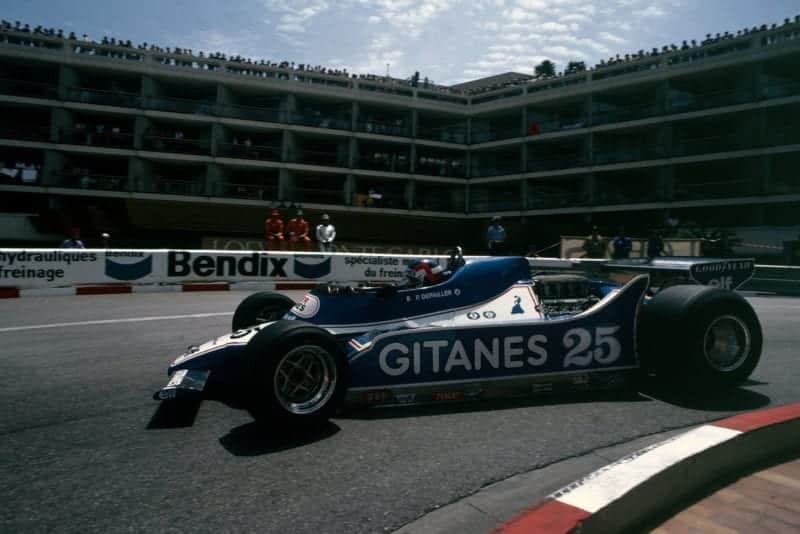
Depailler was registered as the 5th finisher despite retiring with an engine failure
Motorsport Images
All this left Alan Jones in third place, followed by Mass, Jarier and Reutemann, for while the dust was settling from the Pironi/Lauda incident the Lotus 80 was feeling very odd, with a rear wheel steering as well as the front ones. Andretti pulled into the pits to find part of the rear suspension broken. We now had a completely new scene. The two Ferraris were still nose-to-tail with Jones ten seconds behind, but with Lauda and Pironi out of the way the Australian could really give the Williams its head and he stormed up on the cars from Maranello in a splendid fashion, at a second or more per lap. Mass and Jarier were left behind, and Reutemann was dropping back with the harsh-sounding Lotus 79. Then came Regazzoni on his own, followed by Stuck leading Piquet, Watson and Depailler. Jabouille was all on his own at the back and Laffite was still storming along making up lost ground. It had taken Jones ten laps to catch the Ferraris, but now he was with them there wasn’t much he could do, for they were not going to let him go by. For eleven laps Jones sat tight behind the two red cars, and Villeneuve was wishing Scheckter would go a bit faster. A stalemate was developed when suddenly the two Ferraris were on their own, with an air of relief about them. The Williams was heading for the pits for Jones had thumped a barrier with his right front wheel and the steering arm was bent. After a magnificent effort the Williams was out due to driver error, but the team’s Saudi Arabian sponsors who were watching were not too depressed for it had been a great moment for them as the Williams car challenged the Ferraris.
This now left a big gap to Jochen Mass who was still driving hard and had inherited third place for the Arrows team, because Jarier had disappeared with a pretty spectacular “boom” and a cloud of smoke. While bouncing over the kerbs at the exit of the Rascasse corner the right rear upright of the Tyrrell had burst asunder, letting the wheel lean inwards and the drive-shaft run at a steep angle. As Jarier gave it full power and changed up a gear the universal joint broke and the grease hit the exhaust pipe and the car ground to a halt, so Regazzoni moved up to fourth place when his Williams’ team leader retired. One of the front brake cooling ducts on the Arrows was coming adrift and the brake was overheating, causing Mass a lot of anguish, so that Regazzoni was closing on him and on lap 50 went by into third place, while Mass visited the pits to see what could be done for him. Behind him Reutemann was now fourth but was being hard pressed by Piquet, while close behind Watson had Depailler trying to scrabble by.
At the end of lap 54 Scheckter went by on his own! The transmission on Villeneuve’s Ferrari had broken and he coasted into the pit lane and out of the race. Once again the scene had changed and Regazzoni was now in second place and was starting to put all he had into this driving, handling the Williams neatly and tidily, while Scheckter still looked a bit rough and unruly. Watson was being so pressed by Depailler that the two of them were closing up on Piquet and Reutemann and this quartet were really having a go. Regazzoni was down to eight and a half seconds from the Ferrari by lap 58 and everyone was urging him on with terrific enthusiasm, for everyone loves “Regga”. He suddenly lost four seconds on lap 59 as the Williams gearbox selectors played up and he couldn’t get second gear. Undeterred the swarthy Swiss made do without it and started to close the gap once again. From thirteen and a half seconds the gap came down to ten, then eight, then five, but the end of the race was not far off, there were but five laps to go and Scheckter had it all well in hand.
Behind the Williams the Lotus 79 was still ahead of the Brabham-Alfa, but Depailler had at last got his Ligier past Watson’s McLaren, the Ulsterman then almost giving up with exhaustion. Laffite’s brave drive all on his own ended when the gearbox in his Ligier broke, and then the Brabham pit urged Piquet to go faster, which meant try and overtake Reutemann. In his anxiety to please, young Piquet nudged the back of the Lotus 79, without damage, but it put him off his stroke and he nearly stopped. Banging in bottom gear he made a storming restart and promptly broke a drive-shaft! This left only five healthy runners in the race, but they were all on the same lap and within seconds of each other. Mass and Jabouille were still circulating, but many laps behind after pit stops and with three laps to go Regazzoni was only three seconds behind Scheckter. With two to go he was right behind the Ferraris, losing ground on power up the hill, but gaining it back on handling through the wiggly bits. With one lap to go Depailler’s Cosworth engine broke and relieved Reutemann cruised on to third place. There was nothing Regazzoni could do unless Scheckter made a mistake, which was unlikely after 75 laps in the lead, and though the Swiss dodged about a bit behind the Ferrari and made feints as it to try and pass, Scheckter had it all nicely sewn up and they finished lap 76 mere feet apart.
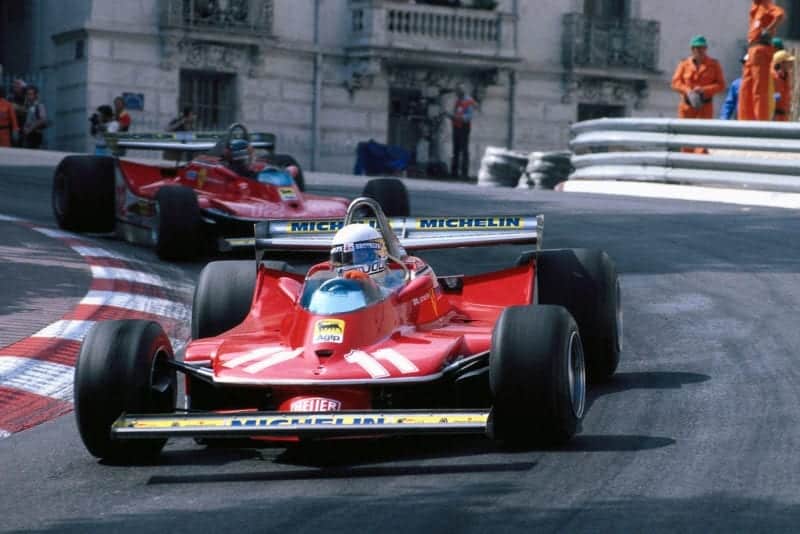
It was a third win of the season for Ferrari’s Jody Scheckter
Motorsport Images
The thousands of Italians were confused, not knowing whether to cheer for Ferrari or for Regazzoni; most of them cheered for “Regga”. The stolid Reutemann notched up another good place for last year’s Lotus, and a grateful Watson finished fourth to give the McLaren team some encouragement, but only thanks to Depailler’s last minute engine failure. It had been a remarkable race, with never a dull moment, and Scheckter nearly achieved the perfect result. He was pole position in practice, led from start to finish, but lost fastest lap to Depailler on lap 69. Monaco had lived up to its reputation of being too narrow for modern wide Formula One cars, but nevertheless provided the scene from a very good motor race and some really hard and skilful driving – D. S. J.
